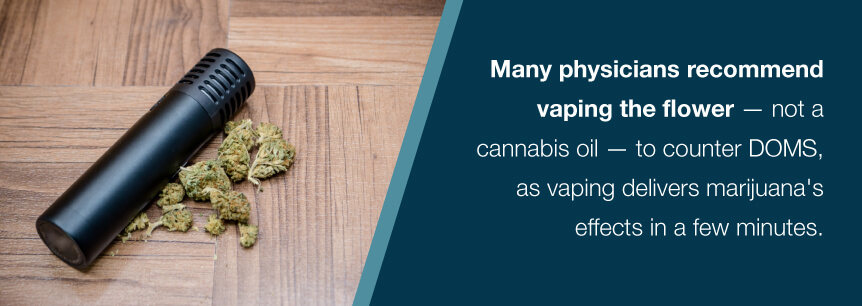
For decades, a stigma has surrounded marijuana use, even for medicinal purposes. Growing research efforts, however, emphasize that cannabis provides an array of benefits to recreational users and patients. In fact, many scientists are discovering that adding marijuana to your workout regimen can help you in several ways, from boosting your metabolism to decreasing your soreness after a workout.
Learn more below about the benefits of marijuana and exercise.
In previous years, due to the legality of medical and recreational cannabis, it was difficult for scientists to understand why marijuana benefited specific conditions and symptoms. Increased opportunities for research, however, have provided answers to marijuana’s health benefits, shedding light on the role of cannabinoids and their interactions with the endocannabinoid system.
Everyone has an endocannabinoid system, which consists of receptors throughout the body. When you use cannabis, such as by eating an edible, your introduce cannabinoids into your body, which often includes the two most well-known cannabinoids, cannabidiol (CBD) and tetrahydrocannabinol (THC). CBD tends to create a less psychoactive experience compared to THC.
As cannabinoids circulate through your body, they bind to your endocannabinoid system’s receptors. This interaction leads to the experiences associated with cannabis, such as pain relief, euphoric feelings and increased appetite. When you use marijuana for exercise recovery, the same process occurs, though the effects you feel may vary depending on your strain and choice of administration.
For many professional athletes as well as weekend warriors, there are several advantages to combining marijuana and exercise. Doing so can achieve the following.
For many runners, the aim is to achieve a runner’s high. A new study suggests, however, that anyone can receive a high from not only running but also consuming cannabis in the preceding four weeks. Why? Our bodies store fat, as well as THC in those fat stores. As with any exercise focused on cardio, such as biking, running and swimming, you burn fat, which leads to the release of those THC stores in small quantities.
As THC enters your bloodstream, it delivers the effects associated with it. What you feel, such as euphoria, will be mild, as your body is releasing only a low amount of THC. Specifically, researchers found that the level of THC increased by 15 percent in participants’ bloodstreams. The experience, however, will give you the boost to push yourself as you exercise, whether by swimming, biking, jogging or another method.
Another study, by the American Journal of Medicine, discovered that marijuana and exercise improve your metabolism. How? By lowering insulin resistance and fasting insulin levels. During their research, the team found that participants using cannabis on a regular basis maintained a fasting insulin level that was 16 percent lower than non-users. A similar gap appeared when comparing insulin resistance levels — marijuana consumers’ levels were 17 percent lower. They also featured smaller-sized waists.
By lowering those key insulin levels, cannabis affects how your body processes and uses sugar. The lower levels indicate that marijuana trains the body to burn sugar for energy, decreasing the amount of sugar stored and improving your metabolism. In comparison, a higher level of insulin and weight gain can indicate that your body is not processing sugar as it should.
A frequent side effect of intensive exercise is delayed onset muscle soreness, also known as DOMS. As a result, many gym-goers and athletes rely on marijuana for exercise recovery. In fact, many professional athletes in the National Football League (NFL) and Ultimate Fighting Championship (UFC) use cannabis following a game or workout session to help offset the pain of DOMS and improve their recovery time following a workout. You can do the same for your exercise regimen.
For many with chronic pain, it’s a challenge to exercise. Cannabis offers a natural treatment that’s trusted by doctors for pain relief. Numerous studies also support the use of marijuana for pain relief, with the most recent report released by the National Academies of Sciences Engineering and Medicine in 2017. An additional benefit of adding marijuana to your workout for pain relief is that it’s safer than nonsteroidal anti-inflammatory drugs (NSAIDs).
NSAIDs, which include ibuprofen, come with several severe risks. If you use an NSAID before beginning your workout, for example, you run the risk of kidney failure, especially if you become dehydrated — researchers are still unsure as to why an NSAID can cause renal failure. Another hazard of relying on NSAIDs versus marijuana for your workout is the development of ulcers, which happen with long-term NSAID use.
If you’re interested in using marijuana for exercise recovery, pain relief or runners high, it’s vital that you integrate it into your workout regimen the right way. Many physicians, for example, recommend vaping the flower — not a cannabis oil — to counter DOMS, as vaping delivers marijuana’s effects in a few minutes. For chronic pain, edibles are a viable option, as they provide long-lasting relief that helps you power through your exercises.

Before choosing your administration method, however, ensure that cannabis is legal in your state for recreational or medicinal purposes.
A variety of strains are available for exercise, including:
Visit your local dispensary to learn more about which strains of marijuana to use for your workout.
At MarijuanaDoctors.com, we provide a compilation of cannabis resources for all experience levels. From our blog to our resource library, we offer the latest information on marijuana, highlighting new legislation, strains, uses, research and more.
Explore our blog to learn more about marijuana and exercise, or search for a doctor near you.
No Information on MarijuanaDoctors.Com should be used to diagnose, treat, prevent or cure any disease or condition. You can view our Full Disclaimer here.